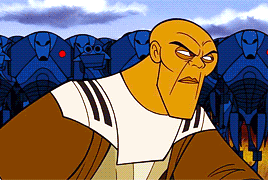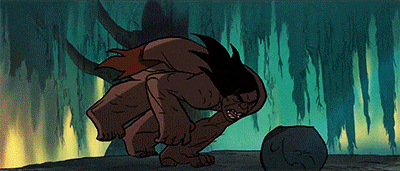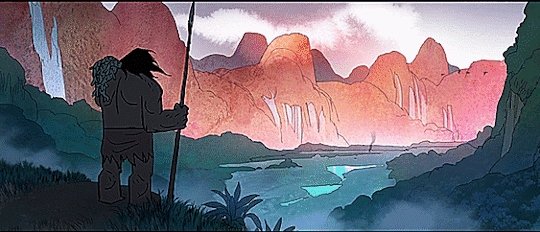originally posted at https://canmom.tumblr.com/post/639662...
Hello friends, it’s Thursday once again! This week we’re taking one of our roughly-once-every-three-weeks breaks from anime to watch something less weebish–oh wait nevermind this is still pretty weebish
Today we’re going to check out a Russian-American animator with a particularly distinctive style: Genndy Tartakovsky, best known for his series Dexter’s Labatory, Samurai Jack, and the original 2003 Clone Wars!

Tartakovsky was born in the USSR in 1970, but while he was a kid, his family migrated to the US via Italy, hoping to shield their kids from antisemitism. As a 7-year-old kid growing up in Chicago, Tartakovsky got pretty into comics - Wikipedia mentions his first was Super Friends. (Not sure exactly what else he’d have been reading in this period, but periodisation-wise this puts us in the ‘bronze age’ of comic books marked by slightly darker storylines and more explicit social allegories, shading into the ‘modern age’ in the 80s.)
Our guy’s intro to animation came, of all places, at advertising school - he had to take a class in animation and it seems to have captivated him so much that he soon ended up going to CalArts to study it seriously. There, he met Craig McCracken, another big animation-industry name who’s known for directing Powerpuff Girls, and made some student films including an early version of Dexter’s Laboratory.

His first job was a minor role on Batman The Animated Series in Spain, but his break came when McCracken put in a good work at Cartoon Network and the studio decided to set up a trailer in their car park (??? that’s… a thing???) where he could work alongside McCracken and Paul Rudish (director of American mecha show Sym-Bionic Titan) on original TV programs. This paid off massively for the studio, because they got a lot of renowned shows.
The animation of this period, Tartakovsky’s especially is characterised by, well, extreme stylisation. In contrast to the ‘solid drawing’ idealised in Disney ‘full animation’ and anime, where we attempt to animate characters in perspective as if they’re 3D figures being shot by a realisticish camera… well, Tartakovsky is all about simple graphic shapes, and motion that’s as straightforward and crystal clear as possible.

What does this get him? It means he can push 2D cinematography to an absolute extreme. When he’s at his best, every Tartakovsky shot is incredibly sharply composed. He loves repeating patterns and motifs, clear geometric shapes, and wordless storytelling with a strong rhythm.
In this he might be compared to Kunihiko Ikuhara, but while Ikuhara tends to use static shots packed with symbolism or spend his budget long repeated sequences that get imbued with meaning the more we see them, Tartakovsky seems to be more about pushing the coolest shots he possibly can. The simplicity of his character designs works because he has an immensely strong sense of gesture and timing - look at that gif above of Mace Windu, it simply skips over most of the frames of his spin where Windu is looking away from the camera, which means his eyes are off-screen for only about a frame and it makes it very easy for our eyes to land on them when they come back around a moment later.

Which brings us to Samurai Jack! Though obviously influenced by jidaigeki and chanbara films given the main character being, well, a samurai!, Jack is mostly a big game of pushing the limits of animated cinematography. It’s incredibly light on dialogue, and indeed continuity: after establishing a basic structure, each episode is an experiment in pastiching a genre leaning on the same basic premise (Jack wants to go back to his original time, the demon very creatively named Aku is his enemy). This does mean it unfortunately leans on national stereotypes as a visual shorthand, which can go badly awry in some cases.
Jack doesn’t always land - the fifth season created much later in particular was quite poorly received, and not every episode’s concept works. But when it does land, it’s something incredibly distinctive - high concepts and genres distilled to their elements and delivered with arresting style.

I haven’t actually seen the vast majority of Jack, so I asked my friends for some fave episodes and hopefully I have a few of the most interesting ones to show you all! My current plan includes the show’s opening, introduction of the recurring character the Scotsman, and popular favourites like ‘Jack learns to Jump good’ and ‘Jack vs ninja’.
Tartakovsky’s style on Jack, and his contributions to shows like Powerpuff Girls, made waves and he started to get a big reputation. This led to him being contacted by another comics fan, George Lucas, to make an animated film set between two films of the Star Wars prequel trilogy. Tartakovsky did so with aplomb, creating a two-hour long series of highly stylised action… one which rather awkwardly outdid Lucas’s own characterisation, establishing lasting popular villains like Ventress and General Grievous.

So, some of Tartakovsky’s characters ended up appearing in the third Star Wars prequel - only to end up with rather unceremonious deaths. It’s interesting to contrast Tartakovsky’s animation with the later live or CG portrayals of the characters! The film’s Grievous is so overwhelmed by busy camerawork and motion blur that he has none of the presence of Tartakovsky’s poses, and following that, Dave Filoni’s series would turn Grievous into an ineffectual, increasingly comic-relief villain always snarling at his underlings. But in Tartakovsky’s hands, he came across as properly sinister, sneaking about to pick off the Jedi one by one before showing off a lively martial arts battle with a lot of great poses…
For some reason, Tartakovsky’s Clone Wars fell out of favour with Lucas, who started working on a new, full-CG show confusingly titled The Clone Wars with Dave Filoni which basically replaced Tartakovsky’s show, and the Mouse upheld this switch. This leads to various continuity wrinkles… but who cares, honestly. More interesting to compare the different ways they go about presenting the same characters and settings imo!

In terms of narrative, Filoni’s series ultimately manages to give the paper-thin characters a lot more depth and later on took some pretty weird and creative turns of his own with some relatively grounded, pretty intense war stories… but perhaps because of the restrictions of working in CG, even the later seasons of The Clone Wars pretty much never feel as stylish as Tartakovsky’s brief shorts. Sadly, the latter half of Tartakovsky’s Clone Wars is wasted by sending Anakin on a long, pointless spirit quest intercut with Obi-Wan fighting a battle that’s actually relevant, but hey, you don’t get to do work like Tartakovsky without having some little idiosyncrasies and obsessions lol.
After Clone Wars, Tartakovsky switched styles for a while, popping over to Sony Pictures Animation to direct a couple of CGI films called Hotel Transylvania. I haven’t seen them but the marketing just looks like any other CG film, to the point where I was surprised to see Tartakovsky’s name… eh. He also started work on a CG interpretation of the classic Fleischer character Popeye, creating a few minutes of animation test in 2016 which are one of the few times I’ve seen CG hit the level of liveliness and flexibility of hand drawn… well, not surprising given Sony Pictures Animation are also the studio behind Spiderverse I guess!
Like his 2D animation, this sequence emphasises hyper-exaggerated poses and rapid motions that snap from one to the other, flexible rigs with a ton of ability to squash and stretch, and super tight timing and choreography. In a certain way you could call it a slapstick version of Kaneda school animation. However, in the end, this take on Popeye was shelved, as was his next project called Can You Imagine? - no idea what that one was but you can hear some music and see one image of it here.
Most recently, he’s back in traditional animation! He came back to Cartoon Network for a somewhat dubious season 5 of Samurai Jack, and most recently in 2009 directed a new show, titled Primal, aiming at streaming platforms…

Primal shows Tartakovsky has become a marketable auteur, which means the animation budget is a lot higher and, because they’re working in a modern digital pipeline, there’s room for a lot of gorgeous textured detail in backgrounds and more complex shading that wasn’t present in Jack etc. But the same ethos of clear, impactful, very tightly composed shots is right there! And if it has something of the look of a Gobelins film, that’s probably because a lot of the animation was done by the French Studio La Cachette, a group of Gobelins grads who created Le Royaume…
The idea of Primal is evidently to draw the general pop-cultural sense of ‘prehistoric times’ as a hypermasculine hyperviolent world; the story is basically: there’s the caveman guy who is constantly attacked by basically all lifeforms in the world and survives by spiral power being the toughest and most violent of the bunch. This is not enough, however, to save his nuclear family from predators. Not long after, he encounters a T. rex (just go with it, this is not about palaeontology lol) mother who’s also lost her kids to the same predators.
Well, the two are initially at odds, but, you guessed it!, develop an unlikely alliance over the course of the series. Tartakovsky describes the series as a character study; we can probably expect a lot of processing trauma and learning to trust each other in between the big epic dinosuar fights.

I admit I bounced off the idea of Primal when I first heard about it, but I had more of a stick up my ass then lmao and now I’m more prepared to give it a shot now to see how they handle it. It looks, at the very least, like it will be an immensely stylish collection of action animation and I hope the character study angle holds up ^^
Overall I feel like the interest in Tartakovsky is like… the stories he’s telling are often so simple, but that gives him room to demonstrate something quite fascinating with the methods he uses to tell them. At the very least it’s probably worth studying for the sake of figuring out a few tricks myself! Next week, we’ll be doing either Sayo Yamamoto or Mamoru Oshii, depending what I’m in the mood for - I’m very keen to show Yamamoto’s work because she’s a very creative director and I’m painfully conscious of the gender balance of these things, but Oshii would also make a fun contrast from Tartakovsky lol.
Anyway! Animation Night 35 will begin at 7pm UK time as usual at twitch.tv/canmom, featuring a selection of episodes from Samurai Jack, Clone Wars, and Primal. Hope to see you there!
Comments